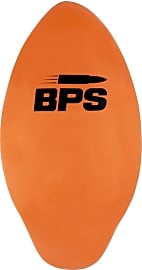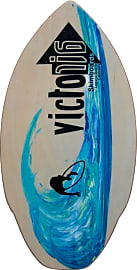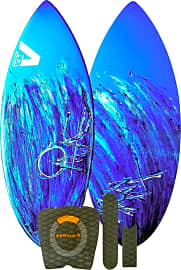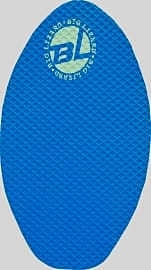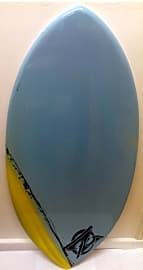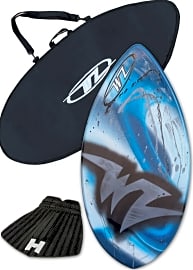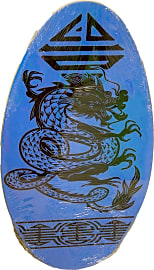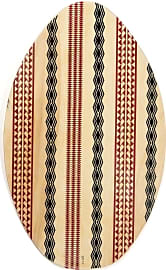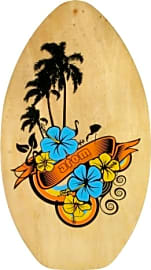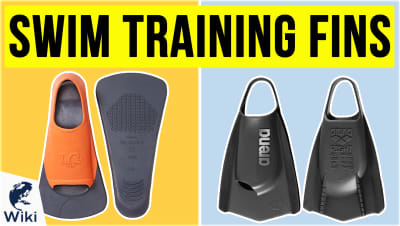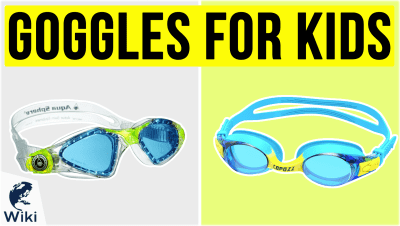The 10 Best Skimboards

This wiki has been updated 38 times since it was first published in February of 2016. For those who are not large enough or experienced enough for a surfboard, these skimboards can provide a lot of fun in a smaller package that’s easier to control. They allow you to glide smoothly across the water’s surface, meet an incoming wave, and ride it back to the shore. They feature lightweight, yet durable, builds, and come in a variety of colors and designs to suit anyone’s taste. When users buy our independently chosen editorial choices, we may earn commissions to help fund the Wiki.
Editor's Notes
June 26, 2020:
If you’re not yet ready for surfing, or just want to stick to something that’s fun but not as complicated, these skimboards might be right for you. They come with sturdy cores and are often covered in a protective, nonslip coating to help ensure your safety as you ride the waves out and back to shore again. In this update, we added in the tried-and-true Exile SuperG, which receives high marks all around for durability, performance, and good looks. It’s constructed from high-quality polyester resin with a PVC foam core, along with sturdy fiberglass reinforcement. You can choose from a handful of fun colors, including eye-catching shades of red, yellow, blue, green, and teal. We also added in the Sunspecs Slip Free, which features a solid wood core with a rubber outer layer that provides traction and eliminates the need to apply any wax. You can choose from a variety of cool colors and decorations like dragons, octopuses, and abstract designs. Leaving the list today is the Liquid Shredder, which tends to warp with use, according to reports.
For a high-quality carbon fiber choice, look to the Fedmax Avac, which is composed of lightweight, yet durable, popular wood, and its nose and tail are reinforced with carbon fiber. It’s also got a protective glossy coating and should give you a smooth ride each time. For an all-in-one set that includes a bottle of wax, a carrying bag with handles and a strap, and a traction pad, consider the Wave Zone Edge. Since it’s made by hand, the cool graphics on each one may look slightly different.
Similar to physically challenging activities like skating, rollerblading, and skateboarding, skimboarding is associated with frequent falls and injuries. To minimize the risk, follow all instructions before venturing out on a skimboard, stretch before using one, and supervise children at all times when they use them. Experts recommend that new users do research on proper technique before riding. Since a child or adult with no knowledge of how to hold or control a skimboard can get seriously injured, you should book private lessons with a professional to learn how to enjoy the sport safely.
Special Honors
Exile Excelsior Dude! Cruise Shorter and wider than your normal skimboard, this model features a wide surface area under your front foot. This helps boost your speed and floating ability, while it also remains highly maneuverable, thanks to its wing and shallow tail design. Its shape planes well and locks in down the line, which comes in handy when you’re up against smaller, further out, or weaker conditions. It’s made with enhanced E-Glass reinforcement, a premium polyester resin, a PVC foam core, and a textured finish. exileskimboards.com
Why Should You Start Skimboarding?
This is generally the essence of skimboarding, a sport that combines some of the most exciting aspects of snowboarding, skateboarding, and surfing.
At a certain point in your trips to the beach, you may have seen some younger teens running up to the shoreline with a relatively short, thin board in their hands. When they reached the shoreline, they threw the board out in front of them and immediately jumped on it, and, depending on their skill level, rode that small board very quickly forward toward an oncoming wave.
This is generally the essence of skimboarding, a sport that combines some of the most exciting aspects of snowboarding, skateboarding, and surfing. For this reason, skimboarding is one of the most exhilarating, yet underappreciated board sports in the world, and one that requires a tremendous amount of discipline to master.
If you are reading this because you’re interested in taking up the sport, you should be pretty excited. Not only are you in for a good time, you’re also going to experience many of the benefits that practitioners of the other sports listed above have experienced for years. These include an increase in athletic prowess and overall physical conditioning, an undeniable camaraderie with anyone around you who is also participating, and the mental fortitude born of refusing to give up in the face of failure. And believe me when I tell you: if you haven’t tried skimboarding before, you are going to fail — and fall — hard.
But that’s OK. As long as you don’t try to brace yourself with your wrists or practice your new favorite hobby too close to a jetty of large rocks, most of your falls should take place in shallow water and soft sand, where mostly minor injuries are likely to occur.
The Physics Of Skimboarding
Whether or not you’ve ever actually experienced the thrill of riding on a skimboard toward a decently sized incoming wave, you may be unaware of exactly how these boards work. If you’ve ever run up to the side of an inground swimming pool and jumped on a raft that was waiting in the water, there’s a good chance that raft immediately sank, without ferrying you along with the speed and excitement that skimboarding would offer. In this example, the raft isn’t necessarily the issue, as you could run up to the side of the swimming pool with a skimboard and sink just as quickly after jumping in.
A surfer, by contrast, will produce a straighter wake line, but a surfboard almost exclusively relies on lift produced by its speed on the water.
What gives a skimboard its functionality is significantly different than what allows a raft, boat, or similar flotation device to move through the water. In the case of a boat, for example, water is pushed back and to the sides by a boat’s propulsion system. That’s why the wake of a boat stretches out in the shape of a V, and this is a relatively inefficient use of the boat’s energy. A surfer, by contrast, will produce a straighter wake line, but a surfboard almost exclusively relies on lift produced by its speed on the water.
A skimboard relies on a different physical mechanism altogether. It doesn’t really push water out from behind it or off to the sides, and the degree to which it utilizes lift is minimal, and is more meant to help keep the nose of the board from dipping the moment you set foot on it and the moment it enters deeper waters. But as a skimboard rushes across a thin film of water — ideally about a quarter of an inch — the pressure of your body weight above the board combines with the pressure of the ground beneath the board to squeeze that thin film of water. This creates something called the ground effect, in which vortexes of water whip up and physically push the board back up away from the ground, allowing it to skim at the very surface of that shallow water.
Choosing Your Skimboard
By far the most important consideration when investing in a new skimboard is its material construction, which will determine everything from its durability to its speed and reach in the water. It will also have the most bearing on price, and this is largely a category in which you get what you pay for. That said, less expensive skimboards aren’t necessarily inferior, they’re just targeted more towards beginners.
The most common material used in the construction of skimboards is closed cell foam. It’s lightweight, relatively inexpensive, and durable enough for most casual skimborders. You’ll also see plenty of options made from wood. These boards, sometimes called woodies, are a little bit heavier than foam varieties, but they’re also a little more durable, making them good choices for young beginners who may be too rough on a foam board.
The most common material used in the construction of skimboards is closed cell foam.
It’s also important to note that many wooden boards are designed for flatland or inland skimming, as their density precludes them from being particularly effective at wave riding. This isn’t such a big issue for beginners, however, as it takes an advanced degree of skill to ride into and catch an oncoming wave.
More experienced riders should look for boards constructed out of fiberglass and carbon fiber. These boards tend to be a little bit more fragile, even despite carbon fiber‘s reputation for durability, but this is because they are designed to be as lightweight as possible. Some fiberglass options will include a slightly heavier, more rugged shell, which is ideal if the beaches you haunt tend to have more debris that could damage a more sensitive board’s exterior.
Features to look for among skimboards beyond material construction include length, shape, and the rocker. Most riders look for a skimboard that will reach roughly mid-torso when stood on end. Shape can also determine how effective a skimboard is at spinning along flat land or at catching and riding waves, with more symmetrical boards proving superior at the former and boards shaped more like surfboards proving superior at the latter.
The rocker is the degree to which the front portion of your skimboard curves upward to prevent the nose from diving down into the wet sand. Many beginner’s models will include a subtle rocker that moves through most of the skimboard, while models designed for tricks may have a rocker that runs the entire length of the skimboard, and models designed for wave riding may only feature a small curve upward at the very nose.


